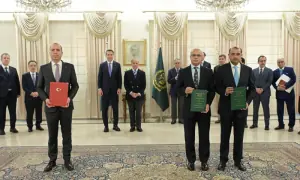IT has finally been officially confirmed that Pakistan is considering using the Chinese currency for bilateral trade.
At a weekly media briefing on Dec 21, Foreign Office spokesman Dr Muhammad Faisal said Pakistan and China “will actively use bilateral currencies for the settlement of bilateral trade and investment (transactions) under the relevant arrangements”.
Explore: Yuan proposal puzzles financial cirlces
In response to a supplementary question, he said, “The two countries aim to promote monetary cooperation between the central banks, implement existing currency-swap arrangements, research to expand the amount of currency and explore to enrich the use and scope of bilateral currency swap [and] assign the foreign currency to domestic banks through credit-based bids to support the financing for projects along the CPEC [China-Pakistan Economic Corridor].”
This means Pakistani and Chinese banks will, in the course of time, be able to open import letters of credit in rupees and yuan (also known as renminbi, or RMB). Moreover, Pakistan will be able to pay for imports from China in yuan rather than in dollars, and Chinese companies investing in CPEC projects will bring in yuan-denominated funds here and remit back their profits and dividends also in yuan instead of dollars or other foreign currencies.
Even non-Chinese companies participating in the CPEC will be able to do that via their Chinese principal companies, senior bankers explain.
“The dollar may remain the most dominating medium of exchange in the foreseeable future. But if Islamabad and Beijing can materialise their dream (to settle bilateral trade and investment transactions in rupees and yuan), we can reduce our dependence on the greenback gradually over a long time,” says the head of a large local bank.
There is a growing trend towards promoting the use of local currencies to settle transactions between two or more countries, as countries seem eager to reduce their overdependence on the US dollar.
As recently as on Dec 11, the central banks of Indonesia, Malaysia and Thailand introduced a framework to boost direct settlement of transactions in their local currencies.
And this makes more sense in the case of Pakistan and China under the CPEC.
Emboldened by its growing global economic clout and out of the necessity to make the yuan a stronger international medium of exchange, China launched a pilot project back in July 2009 to use yuan for cross-border settlements.
The scheme was then developed into a full-fledged framework the very next year, and now hundreds of thousands of Chinese companies transact businesses in yuan with their partners in Hong Kong and some countries of the Association of Southeast Asian Nations.
Besides, after the yuan attained the status of a global reserve currency — the third one after the US dollar and the euro — on Nov 30, 2016, China speeded up efforts for greater use of its own currency for settling transactions with other nations.
For Pakistan, the rupee-yuan settlement of trade with China is important because “it would reduce our needs for US dollars to a significant extent as our imports from China are in excess of $10bn”, explains a central banker.
Initially, even if 25pc of our imports from China are to be financed in yuan, our dollar requirements would decline by $2.5bn within a year.
But, of course, there’s many a slip ‘twixt cup and lip. “The Chinese banking system is used to handling transactions in yuan and other regional currencies (of the countries with which direct settlement of transactions are going on), but we are not,” a treasurer of a local bank says.
The State Bank of Pakistan (SBP) may come up with a framework for this purpose in some weeks or hardly a few months, but for banks to get used to the new system will be a challenge, he says. “An even bigger challenge for bankers will be to explain it to businessmen how the rupee-yuan settlement of transactions would work and how their businesses would benefit from it.”
Bankers recall that there was no big response when the SBP invited bids in 2013 for buying yuan by local banks under a bilateral currency-swap arrangement, which was initially signed in December 2011.
That swap was worth Rs140bn and 10bn yuan. Many bank treasurers don’t exactly remember any activity undertaken so far under this currency-swap framework.
“But as we are entering 2018, things have changed a lot. The country is struggling with its external account imbalance and, thanks to CPEC, investment and trade (read imports) activity is growing rapidly,” a local bank treasurer says. “So, enlarging the scope of the currency swap and utilising it for settling trade and investment transactions between Pakistan and China can really help in keeping external-sector problems in check.”
Now, as we badly need yuan to foot the growing Chinese import bill so that growth in imports and other foreign-currency obligations does not create an unmanageable need for US dollars, only enlarging the amount of rupee-yuan swaps will not be enough.
“What is perhaps more necessary is to sensitise banks and businesses about it and make sure that when the yuan is auctioned in the interbank market for swap against the rupee, banks participate in a big way and they actually do this on the back of corporate-driven demand,” a forex dealer at a local bank says.
As a next step, promoting the clearance and settlement of claims of financial institutions through a cross-border interbank payment system is also a must. And Pakistan and China have already agreed upon doing this, according to the Foreign Office spokesman.
Once concrete developments are made in this regard, the free flow of capital and cross-border transfer of legitimate funds between the two countries would become easier, reducing the need for more complex centralised international clearing system in New York and London.
Published in Dawn, The Business and Finance Weekly, December 25th, 2017


































